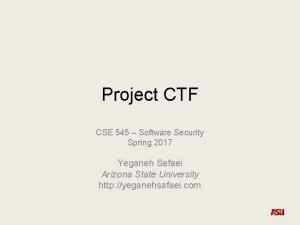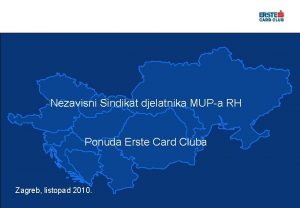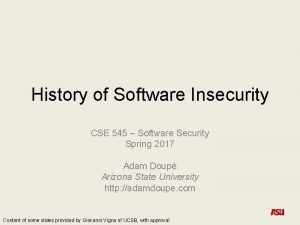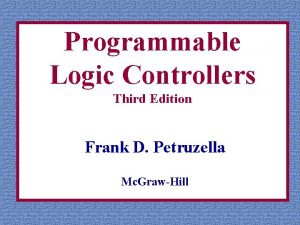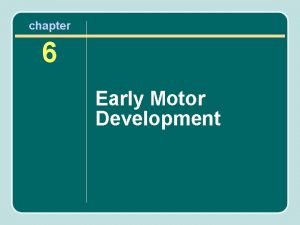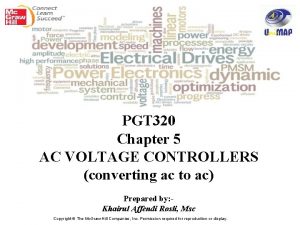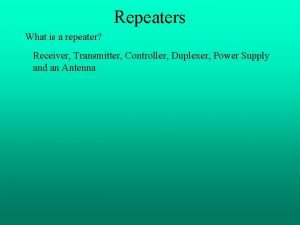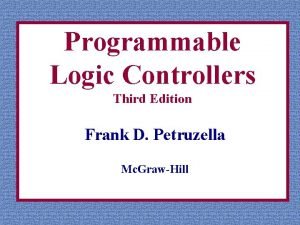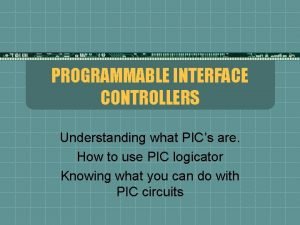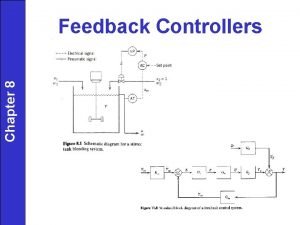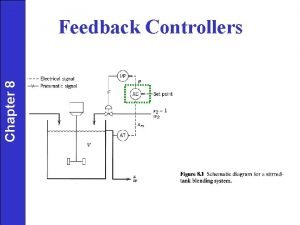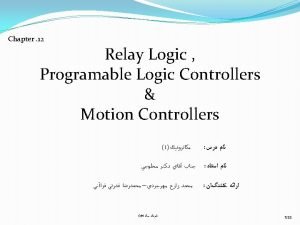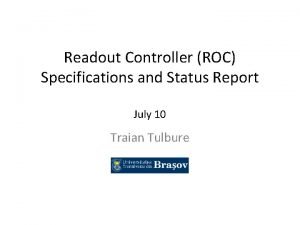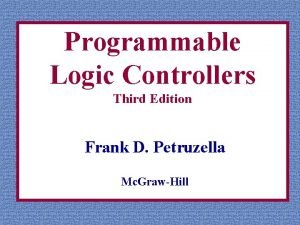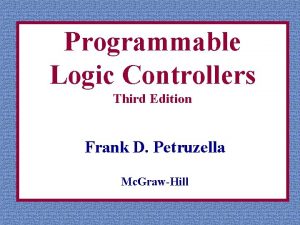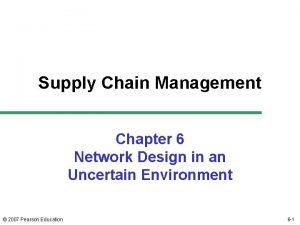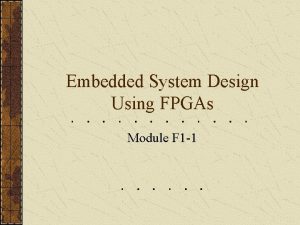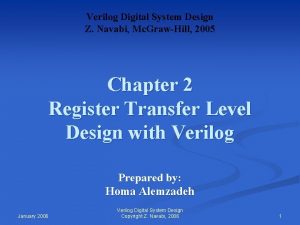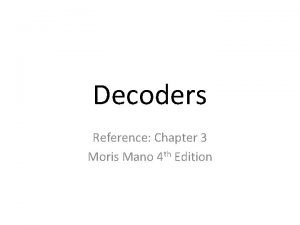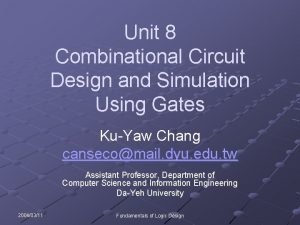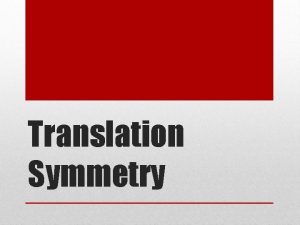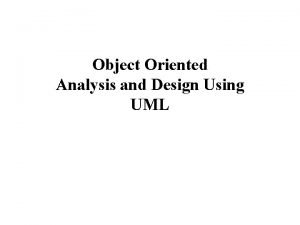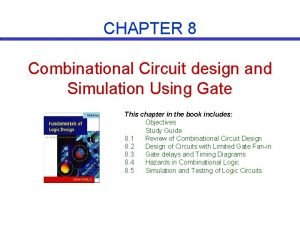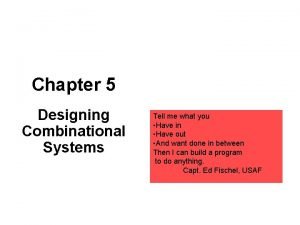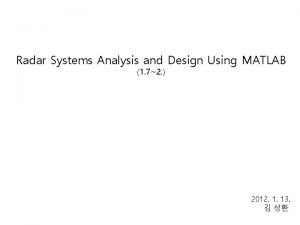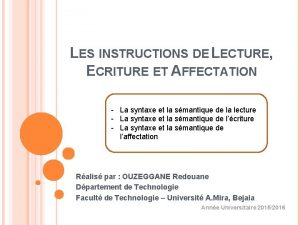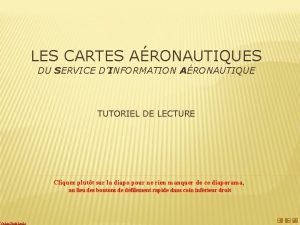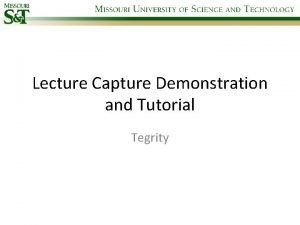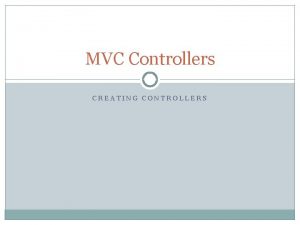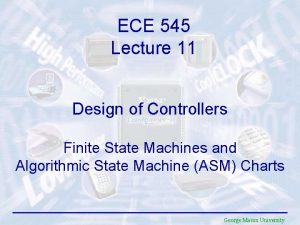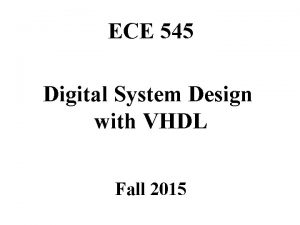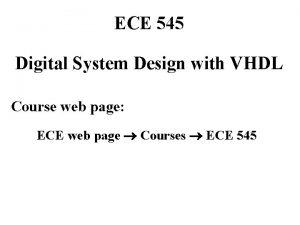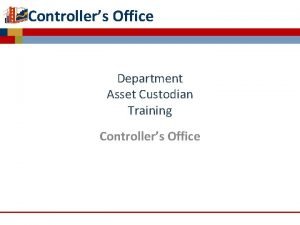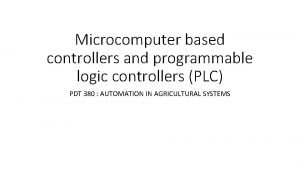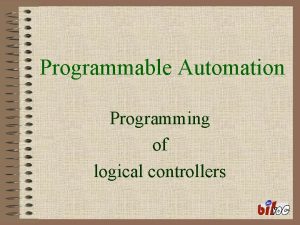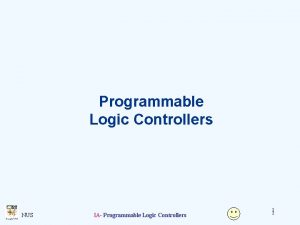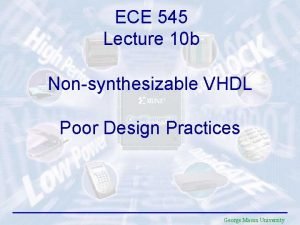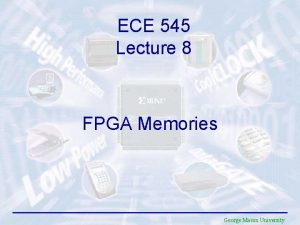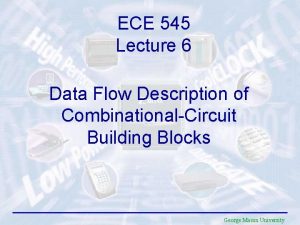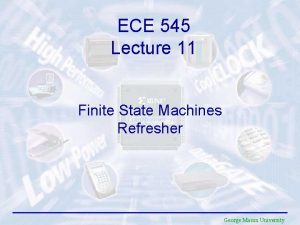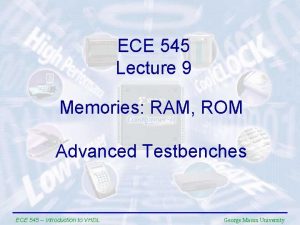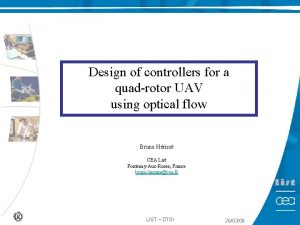ECE 545 Lecture 12 Design of Controllers using



























































![Protocol (1) An external circuit first loads all round keys S[0], S[1], S[2], …, Protocol (1) An external circuit first loads all round keys S[0], S[1], S[2], …,](https://slidetodoc.com/presentation_image_h/3728bf782063c7b97334e7ea1f340c2e/image-60.jpg)



























- Slides: 87

ECE 545 Lecture 12 Design of Controllers using Algorithmic State Machine (ASM) Charts George Mason University

Required reading • P. Chu, RTL Hardware Design using VHDL Chapter 11, Register Transfer Methodology: Principle 2

Recommended reading • P. Chu, RTL Hardware Design using VHDL Chapter 12, Register Transfer Methodology: Practice 3

Slides based partially on • S. Brown and Z. Vranesic, Fundamentals of Digital Logic with VHDL Design Chapter 8, Synchronous Sequential Circuits Sections 8. 1 -8. 5 Chapter 8. 10, Algorithmic State Machine (ASM) Charts Chapter 10. 2 Design Examples 4

Structure of a Typical Digital System Data Inputs Datapath (Execution Unit) Control & Status Inputs Control Signals Controller (Control Unit) Status Signals Data Outputs Control & Status Outputs

Hardware Design with RTL VHDL Pseudocode Datapath Interface Controller Block diagram VHDL code ASM chart VHDL code

Steps of the Design Process Introduced in Class Today 1. 2. 3. 4. 5. Text description Interface Pseudocode Block diagram of the Datapath Interface with the division into Datapath and Controller 6. ASM chart of the Controller 7. RTL VHDL code of the Datapath, Controller, and Top-Level Unit 8. Testbench of the Datapath, Controller, and Top-Level Unit 9. Functional simulation and debugging 10. Synthesis and post-synthesis simulation 11. Implementation and timing simulation 12. Experimental testing

Generalized FSM Based on RTL Hardware Design by P. Chu 8

Generalized FSM Inputs Next State function Next State clock reset Present State Register Mealy Output function Moore Output function Mealy Outputs Moore Outputs Present State 9

Algorithmic State Machine (ASM) Charts ECE 448 – FPGA and ASIC Design with VHDL 10

Algorithmic State Machine – representation of a Finite State Machine suitable for FSMs with a larger number of inputs and outputs compared to FSMs expressed using state diagrams and state tables. 11

ASM Chart – Flowchart-like diagram – Provides the same info as a state diagram – More descriptive, better for complex description 12

Elements used in ASM charts (1) State name Output signals or actions (Moore type) 0 (False) (a) State box Condition expression 1 (True) (b) Decision box Conditional outputs or actions (Mealy type) (c) Conditional output box 13

State Box • State box – represents a state. • Equivalent to a node in a state diagram or a row in a state table. • Contains register transfer actions or output signals • Moore-type outputs are listed inside of the box. • It is customary to write only the name of the signal that has to be asserted in the given state, e. g. , z instead of z<=1. • Also, it might be useful to write an action to be taken, e. g. , count <= count + 1, and only later translate it to asserting a control signal that causes a given action to take place (e. g. , enable signal of a counter). State name Output signals or actions (Moore type) 14

Decision Box • Decision box – indicates that a given condition is to be tested and the exit path is to be chosen accordingly. The condition expression may include one or more inputs to the FSM. 0 (False) Condition expression 1 (True) 15

Conditional Output Box • Conditional output box • Denotes output signals that are of the Mealy type. • The condition that determines whether such outputs are generated is specified in the decision box. Conditional outputs or actions (Mealy type) 16

Counting: Block diagram + ASM ECE 448 – FPGA and ASIC Design with VHDL 17

Counting: Timing waveforms ECE 448 – FPGA and ASIC Design with VHDL 18

ASMs representing simple FSMs • Algorithmic state machines can model both Mealy and Moore Finite State Machines • They can also model machines that are of the mixed type 19

Moore FSM – Example 1: State diagram Reset w = 1 w = 0 A¤z=0 B¤z= 0 w = 1 w = 0 C¤z = 1 w = 1 20

Moore FSM – Example 1: State table Next state Present state w = 0 w = 1 A B C A A A B C C Output z 0 0 1 21

ASM Chart for Moore FSM – Example 2 22

Moore FSM process(clock, reset) Inputs Next State function Next State clock reset concurrent statements Present State Register Present State Output function Outputs 23

Example 1: VHDL code (1) USE ieee. std_logic_1164. all ; ENTITY simple IS PORT ( clock resetn w z END simple ; : IN STD_LOGIC ; : OUT STD_LOGIC ) ; ARCHITECTURE Behavior OF simple IS TYPE State_type IS (A, B, C) ; SIGNAL y : State_type ; BEGIN PROCESS ( resetn, clock ) BEGIN IF resetn = '0' THEN y <= A ; ELSIF rising_edge(clock) THEN 24

Example 1: VHDL code (2) CASE y IS WHEN A => IF w = ‘ 1' THEN y <= B ; ELSE y <= A ; END IF ; WHEN B => IF w = ‘ 1' THEN y <= C ; ELSE y <= A ; END IF ; WHEN C => IF w = '0' THEN y <= A ; ELSE y <= C ; END IF ; END CASE ; 25

Example 1: VHDL code (3) END IF ; END PROCESS ; z <= '1' WHEN y = C ELSE '0' ; END Behavior ; 26

Mealy FSM – Example 2: State diagram Reset w = 1¤z= 0 w = 0¤z= 0 A B w = 1¤z= 1 w = 0¤z= 0 27

ASM Chart for Mealy FSM – Example 2 28

Mealy FSM process(clock, reset) Inputs Next State function Next State clock reset concurrent statements Present State Register Output function Outputs 29

Example 3: VHDL code (1) LIBRARY ieee ; USE ieee. std_logic_1164. all ; ENTITY Mealy IS PORT ( clock : IN resetn : IN w : IN z : OUT END Mealy ; STD_LOGIC ; STD_LOGIC ) ; ARCHITECTURE Behavior OF Mealy IS TYPE State_type IS (A, B) ; SIGNAL y : State_type ; BEGIN PROCESS ( resetn, clock ) BEGIN IF resetn = '0' THEN y <= A ; ELSIF rising_edge(clock) THEN 30

Example 3: VHDL code (2) CASE y IS WHEN A => IF w = ‘ 1' THEN y <= B ; ELSE y <= A ; END IF ; WHEN B => IF w = '0' THEN y <= A ; ELSE y <= B ; END IF ; END CASE ; 31

Example 3: VHDL code (3) END IF ; END PROCESS ; z <= '1' WHEN (y = B) AND (w=‘ 1’) ELSE '0' ; END Behavior ; 32

Control Unit Example: Arbiter (1) reset g 1 r 2 Arbiter g 2 g 3 r 3 clock 33

Control Unit Example: Arbiter (2) 000 Reset Idle 0 -- 1 -- gnt 1 ¤ g 1 = 1 -0 - 1 -- 01 - gnt 2 ¤ g 2 = 1 --0 -1 - 001 gnt 3 ¤ g 3 = 1 --1 34

Control Unit Example: Arbiter (3) 35

ASM Chart for Control Unit - Example 4 36

Moore FSM process(clock, reset) Inputs Next State function Next State clock reset concurrent statements Present State Register Present State Output function Outputs 37

Example 4: VHDL code (1) LIBRARY ieee; USE ieee. std_logic_1164. all; ENTITY arbiter IS PORT ( Clock, Resetn r g END arbiter ; : IN : OUT STD_LOGIC ; STD_LOGIC_VECTOR(1 TO 3) ) ; ARCHITECTURE Behavior OF arbiter IS TYPE State_type IS (Idle, gnt 1, gnt 2, gnt 3) ; SIGNAL y : State_type ; 38

Example 4: VHDL code (2) BEGIN PROCESS ( Resetn, Clock ) BEGIN IF Resetn = '0' THEN y <= Idle ; ELSIF rising_edge(Clock) THEN CASE y IS WHEN Idle => IF r(1) = '1' THEN y <= gnt 1 ; ELSIF r(2) = '1' THEN y <= gnt 2 ; ELSIF r(3) = '1' THEN y <= gnt 3 ; ELSE y <= Idle ; END IF ; WHEN gnt 1 => IF r(1) = '0' THEN y <= Idle ; ELSE y <= gnt 1 ; END IF ; WHEN gnt 2 => IF r(2) = '0' THEN y <= Idle ; ELSE y <= gnt 2 ; END IF ; 39

Example 4: VHDL code (3) WHEN gnt 3 => IF r(3) = '0' THEN y <= Idle ; ELSE y <= gnt 3 ; END IF ; END CASE ; END IF ; END PROCESS ; g(1) <= '1' WHEN y = gnt 1 ELSE '0' ; g(2) <= '1' WHEN y = gnt 2 ELSE '0' ; g(3) <= '1' WHEN y = gnt 3 ELSE '0' ; END Behavior ; 40

Exercise Assuming ASM chart given on the next slide, supplement timing waveforms given in the answer sheet with the correct values of signals State, g 1, g 2, g 3, in the interval from 0 to 575 ns.

ASM Chart 42

Reset Clk r 1 r 2 r 3 State g 1 g 2 g 3 0 ns 100 ns 200 ns 300 ns 400 ns 500 ns

ASM Block • One state box • One or more (optional) decision boxes: with T (1) or F (0) exit paths • One or more (optional) conditional output boxes: for Mealy outputs 44

ASM Chart Rules • Difference between a regular flowchart and an ASM chart: – Transition governed by clock – Transition occurs between ASM blocks • Basic rules: – For a given input combination, there is one unique exit path from the current ASM block – Any closed loop in an ASM chart must include a state box Based on RTL Hardware Design by P. Chu 45

Incorrect ASM Charts Based on RTL Hardware Design by P. Chu 46

Class Exercise 1 STATISTICS

Pseudocode no_1 = no_2 = no_3 = sum = 0 for i=0 to k-1 do sum = sum + din if din > no_1 then no_3 = no_2 = no_1 = din elseif (din > no_2) then no_3 = no_2 = din elseif (din > no_3) then no_3 = din end if end for avr = sum / k

Circuit Interface clk done reset din go n n Statistics 2 dout_mode

Interface Table Port Width Meaning clk 1 System clock. reset 1 System reset. din n Input Data. go 1 Control signal indicating that the first input will be ready in the next clock cycle. Active for one clock cycle. done 1 Signal set to high after the output is ready. dout n Output dependent on the dout_mode input. dout_mode 2 Control signal determining value available at the output. 00: avr, 01: no_1, 10: no_2, 11: no_3.

din n en 1 n+m clk n+m esum clk en clk rst no_1 n n reset 1 sum n+m en 2 clk 0 rst n n clk avr no_1 no_2 no_3 n n 01 gt 1 B enc clk no_2 A A>B en clk rst gt 2 0 reset m B 1 en 3 A>B reset n >> m A s 2 en clk n+m 00 reset i s 3 = k-1 en clk rst n reset no_3 A B A>B gt 3 zi n 10 11 dout_mode 2 n dout Block diagram of the Datapath

Interface with the division into the Datapath and the Controller din dout_mode n clk reset go 2 Datapath gt 1 gt 2 gt 3 zi Controller en 1 en 2 en 3 esum enc s 2 s 3 n dout done

ASM Charts

Class Exercise 2 CIPHER

Pseudocode Split input I into four words, I 3, I 2, I 1, I 0, of the size of w bits each A = I 3; B = I 2; C = I 1; D=I 0 B = B + S[0] D = D + S[1] for i = 1 to r do { T = (B*(2 B + 1)) <<< k U = (D*(2 D + 1)) <<< k A = ((A ⊕ T) <<< U) + S[2 i] C = ((C ⊕ U) <<< T) + S[2 i + 1] (A, B, C, D) = (B, C, D, A) } A = A + S[2 r + 2] C = C + S[2 r + 3] O = (A, B, C, D)

Notation w: word size, e. g. , w=8 (constant) k: log 2(w) (constant) A, B, C, D, U, T: w-bit variables I 3, I 2, I 1, I 0: Four w-bit words of the input I r: number of rounds (constant) O: output of the size of 4 w bits S[j] : 2 r+4 round keys stored in two RAMs. Each key is a w-bit word. The first RAM stores values of S[j=2 i], i. e. , only round keys with even indices. The second memory stores values of S[j=2 i+1], i. e. , only round keys with odd indices.

Operations ⊕ : XOR + : addition modulo 2 w – : subtraction modulo 2 w * : multiplication modulo 2 w X <<< Y : rotation of X to the left by the number of positions given in Y X >>> Y : rotation of X to the right by the number of positions given in Y (A, B, C, D) : Concatenation of A, B, C, and D.

Circuit Interface clk reset 4 w 4 w I CIPHER write_I Sj w Write_Sj j m O DONE

Interface Table Note: m is a size of index j. It is a minimum integer, such that 2 m -1 2 r+3.
![Protocol 1 An external circuit first loads all round keys S0 S1 S2 Protocol (1) An external circuit first loads all round keys S[0], S[1], S[2], …,](https://slidetodoc.com/presentation_image_h/3728bf782063c7b97334e7ea1f340c2e/image-60.jpg)
Protocol (1) An external circuit first loads all round keys S[0], S[1], S[2], …, S[2 r+2], [2 r+3] to the two internal memories of the CIPHER unit. The first memory stores values of S[j=2 i], i. e. , only round keys with even indices. The second memory stores values of S[j=2 i+1], i. e. only round keys with odd indices. Loading round keys is performed using inputs: Sj, j, write_Sj, clk. Then, the external circuits, loads an input block I to the CIPHER unit, using inputs: I, write_I, clk. After the input block I is loaded to the CIPHER unit, the encryption starts automatically.

Protocol (2) When the encryption is completed, signal DONE becomes active, and the output O changes to the new value of the ciphertext. The output O keeps the last value of the ciphertext at the output, until the next encryption is completed. Before the first encryption is completed, this output should be equal to zero.

Assumptions • 2 r+4 clock cycles are used to load round keys to internal RAMs • one round of the main for loop of the pseudocode executes in one clock cycle • you can access only one position of each internal memory of round keys per clock cycle As a result, the encryption of a single input block I should last r+2 clock cycles.

=2 D+1


Memories of Round Keys – Contents Case of r=2

Memories of Round Keys – Circuit S 2 i

Counter 0 m-1 eni en ldi ld reset rst clk m-1 i ==r zi

Interface with the Division into the Datapath and Controller

Pseudocode Split input I into four words, I 3, I 2, I 1, I 0, of the size of w bits each A = I 3; B = I 2; C = I 1; D=I 0 B = B + S[0] D = D + S[1] for i = 1 to r do { T = (B*(2 B + 1)) <<< k U = (D*(2 D + 1)) <<< k A = ((A ⊕ T) <<< U) + S[2 i] C = ((C ⊕ U) <<< T) + S[2 i + 1] (A, B, C, D) = (B, C, D, A) } A = A + S[2 r + 2] C = C + S[2 r + 3] O = (A, B, C, D)

Pseudocode Split input I into four words, I 3, I 2, I 1, I 0, of the size of w bits each A = I 3 B = I 2 + S[0] C = I 1 D = I 0 + S[1] for i = 1 to r do { T = (B*(2 B + 1)) <<< k U = (D*(2 D + 1)) <<< k A’ = ((A ⊕ T) <<< U) + S[2 i] C’ = ((C ⊕ U) <<< T) + S[2 i + 1] (A, B, C, D) = (B, C’, D, A’) } A = A + S[2 r + 2] C = C + S[2 r + 3] O = (A, B, C, D)

Pseudocode Split input I into four words, I 3, I 2, I 1, I 0, of the size of w bits each A = I 3; B = I 2 + S 2 i; C = I 1; D = I 0 + S 2 ip 1 for i = 1 to r do { T = (B*(2 B + 1)) <<< k U = (D*(2 D + 1)) <<< k A’ = ((A ⊕ T) <<< U) + S[2 i] C’ = ((C ⊕ U) <<< T) + S[2 i + 1] (A, B, C, D) = (B, C’, D, A’) } O = (A + S 2 i, B, C + S 2 ip 1, D)

reset S_wait i=0 F S_wait ldi write_I F write_I T T A=I 3; B=I 2+S 2 i C=I 1; D=I 0+S 2 ip 1 i++ S_loop A=B; B=C’ C=D; D=A’ i==r init, enr eni S_loop enr i++ F T i++ S_done O=(A+S 2 i, B, C+S 2 ip 1, D) DONE F zi T eni S_done eno DONE

reset S_wait i=0 F S_wait ldi write_I F write_I T T A=I 3; B=I 2+S 2 i C=I 1; D=I 0+S 2 ip 1 i++ S_loop A=B; B=C’ C=D; D=A’ i++ i==r init, enr eni F T T S_done O=(A+S 2 i, B, C+S 2 ip 1, D) DONE F zi S_done eno DONE

Alternative Coding Styles 74

Traditional Coding Style process(clock, reset) Inputs Next State function Next State clock reset Present State Register Mealy Output function Moore Output function Mealy Outputs Moore Outputs Present State concurrent statements 75

Alternative Coding Style 1 Process(Present State, Inputs) Inputs Next State function Next State clock reset Process(Present State, Inputs) Process(clock, reset) Present State Register Present State Process(Present State) Mealy Output function Moore Output function Mealy Outputs Moore Outputs 76

oe <= 1 RTL Hardware Design by P. Chu Chapter 10 77

78

79

80

81

82

Alternative Coding Style 2 Process(Present State, Inputs) Process(clk, reset) 83

oe <= 1 RTL Hardware Design by P. Chu Chapter 10 84

85

86

87
 Cse 545
Cse 545 Mse data science upenn
Mse data science upenn Cse 545 asu github
Cse 545 asu github 486 dibagi 6 dengan cara bersusun
486 dibagi 6 dengan cara bersusun 01 4929 545
01 4929 545 Nia 545
Nia 545 Cse 545
Cse 545 545 lecrim
545 lecrim 01:640:244 lecture notes - lecture 15: plat, idah, farad
01:640:244 lecture notes - lecture 15: plat, idah, farad Fsu controller office
Fsu controller office Programmable logic controllers frank petruzella
Programmable logic controllers frank petruzella Rate limiters in motor development
Rate limiters in motor development Ac voltage regulator using triac
Ac voltage regulator using triac Frc pdp
Frc pdp Riverbed gartner sd wan
Riverbed gartner sd wan How we love vacillator
How we love vacillator Ac voltage controllers convert
Ac voltage controllers convert Controllers & repeaters
Controllers & repeaters The control plan stored in the plc is called *
The control plan stored in the plc is called * Pic logicator
Pic logicator Active clamp flyback
Active clamp flyback The controllers chapter 8
The controllers chapter 8 Reverse and direct acting controller
Reverse and direct acting controller Relay logic controllers
Relay logic controllers Plunger lift controllers
Plunger lift controllers Roc-2015 ro controllers supplier
Roc-2015 ro controllers supplier Transfer function of pid controller is
Transfer function of pid controller is Programmable logic controllers frank d petruzella
Programmable logic controllers frank d petruzella Programmable logic controllers frank d petruzella
Programmable logic controllers frank d petruzella Eurocode reinforcement detailing
Eurocode reinforcement detailing Elemen urban design
Elemen urban design Elements of design in interior design ppt
Elements of design in interior design ppt Lecture hall background
Lecture hall background Game design lecture
Game design lecture Computer-aided drug design lecture notes
Computer-aided drug design lecture notes Cmos vlsi design lecture notes
Cmos vlsi design lecture notes Linda milor
Linda milor Using system using system.collections.generic
Using system using system.collections.generic Accumulator ac
Accumulator ac Supply chain network design decisions
Supply chain network design decisions The westing game anticipation guide
The westing game anticipation guide Embedded microprocessor system design using fpgas
Embedded microprocessor system design using fpgas Digital systems design using verilog
Digital systems design using verilog Pla vs pal
Pla vs pal Design a 4-to-16 decoder using 2-to-4 decoders only.
Design a 4-to-16 decoder using 2-to-4 decoders only. Combinational circuit design and simulation using gates
Combinational circuit design and simulation using gates Strip pattern symmetry
Strip pattern symmetry Radar range equation snr
Radar range equation snr Object-oriented systems analysis and design using uml
Object-oriented systems analysis and design using uml Object oriented analysis and design using uml
Object oriented analysis and design using uml Network systems design using network processors
Network systems design using network processors Combinational circuit design and simulation using gates
Combinational circuit design and simulation using gates Design a combinational circuit using rom
Design a combinational circuit using rom Radar system analysis and design using matlab
Radar system analysis and design using matlab Project procurement management lecture notes
Project procurement management lecture notes Lecture about sport
Lecture about sport Lecture on healthy lifestyle
Lecture on healthy lifestyle Meaning of this
Meaning of this Meaning of this
Meaning of this Randy pausch last lecture summary
Randy pausch last lecture summary Tensorflow lecture
Tensorflow lecture Theology proper lecture notes
Theology proper lecture notes Strategic management lecture
Strategic management lecture Geology lecture series
Geology lecture series Social psychology lecture
Social psychology lecture In text citation for a lecture
In text citation for a lecture Lecture notes on public sector accounting ghana pdf
Lecture notes on public sector accounting ghana pdf Lecture notes on project management
Lecture notes on project management Electricity and magnetism lecture notes
Electricity and magnetism lecture notes Classical mechanics
Classical mechanics Physics 101 lecture notes pdf
Physics 101 lecture notes pdf Physical science lecture notes
Physical science lecture notes Power system dynamics and stability lecture notes
Power system dynamics and stability lecture notes Natural language processing
Natural language processing Microbial physiology lecture notes
Microbial physiology lecture notes Application of mechatronics ppt
Application of mechatronics ppt Limits fits and tolerances
Limits fits and tolerances Objectifs de lecture
Objectifs de lecture Instruction de lecture
Instruction de lecture Aronautique
Aronautique Lecture title
Lecture title Lecture presentations for campbell biology
Lecture presentations for campbell biology Financial engineering notes
Financial engineering notes Bjt
Bjt Software engineering lecture notes
Software engineering lecture notes Katus lighting
Katus lighting Le dernier jour d'un condamné chapitre 49 résumé
Le dernier jour d'un condamné chapitre 49 résumé Tegrity lecture capture
Tegrity lecture capture
